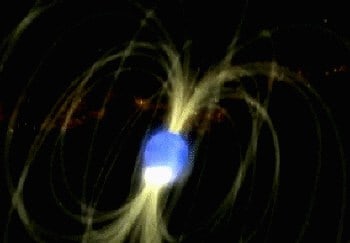
The first fast radio burst (FRB) detected in the Milky Way appears to be coming from a magnetar, which is a highly magnetic neutron star. If magnetars are confirmed to be a source of FRBs, it would be a huge leap forward in our understanding of these mysterious bursts.
The double-peaked FRB comprised two rapid-fire radio bursts that arrived within 28.9 ms of one another on 28 April 2020. The signal came from the direction of the magnetar SGR 1935+2154, which is located an estimated 30,000 light-years away near the centre of the Milky Way. The FRB was first detected by the Canadian Hydrogen Intensity Mapping Experiment (CHIME), which is a radio telescope at the Dominion Radio Astrophysical Observatory in British Columbia.
Earlier in April, there had been a flurry of X-ray flares detected by NASA’s Swift satellite, and two stronger-than-average flares were seen to occur at exactly the same time as the radio bursts.
Powerful signal
The FRB is about 3000 times more powerful than any radio emissions previously detected from a known magnetar. However, it is still ten times weaker than the weakest extragalactic FRB.
This means that the FRB would probably not have been detected if it originated from outside the Milky Way, says Kiyoshi Masui of the Massachusetts Institute of Technology, who is an author of a paper in Nature describing the discovery. The FRB was also seen by astronomers working on the STARE2 radio telescope in the US, who also report in Nature. A third team used the FAST telescope in China to do follow-up observations and has also published in Nature.
The nearest extragalactic magnetar is about 500 million light-years away. Had the burst from SGR 1935+2154 occurred at that distance, it would have appeared 200 million times fainter. “However, there are presumably many extragalactic FRBs that are too faint for us to see, so this burst would have been in that category,” adds Masui.
There are currently less than 30 known magnetars in the Milky Way. This small number “makes life hard” when trying to understand their behaviour, says Adam Deller, who is an astrophysicist at Swinburne University of Technology in Australia, and who was not involved in the research.
Secure link needed
However, “If we can make a secure link between the type of burst that this galactic magnetar gives off and extragalactic FRBs, then having a source on our doorstep is game-changing,” he says. It would allow astronomers to observe features that are too faint to be seen in FRBs in other galaxies, such as weaker bursts and X-ray flares. Indeed, follow-up observations have already detected more radio bursts coming from SGR 1935+2154, but these have so far been much weaker than April’s double-peaked FRB.
Earlier this year, Deller was part of a team of scientists who used parallax to measure the precise distance to a magnetar called XTE J1810-197. This is the first magnetar known to emit radio pulses, albeit far less energetic than an FRB. Knowing the distance to the magnetar allows scientists to calculate the strength of its radio emissions. This allowed the team to estimate that the SGR 1935+2154 FRB is thousands of times brighter than the radio pulses emanating from XTE J1810-197.
Despite the discovery, scientists still do not understand the mechanism by which a magnetar can produce an FRB, or even if all FRBs are produced by magnetars. Observations show that FRBs can be divided into at least two population types – those that repeat, which include SGR 1935+2154, and much more powerful blasts that appear to be one-off events.
Quantum effects
Proposals for the FRB mechanism include synchrotron masers and even asteroids colliding with magnetars. One other popular theory is that quantum effects produce a torrent of electrons that interact with a magnetar’s incredibly strong magnetic field, which in the case of SGR 1935+2154 has a strength of 2.2×1014 gauss.

The biggest bang
“Near magnetars, the magnetic field is so strong that it can cause pairs of electrons and positrons to be spontaneously created out of the vacuum using energy contained in the magnetic field,” says Masui. These electrons then move like electric currents through the magnetic field, producing the brief blasts of radio waves.
To confirm that at least some extragalactic FRBs are produced by magnetars, astronomers would like to see X-ray bursts coincide with an FRB, as was the case with SGR 1935+2154. However, given the undetermined formation mechanism of FRBs, it is not clear what their relationship with the X-ray flares are.
“They must be related in some way, but it’s funny that X-rays are not always accompanied by radio bursts,” says Masui. Understanding that connection, through study of SGR 1935+2154 and other magnetars, could be the key to unlocking at least some of the mysteries surrounding FRBs.



